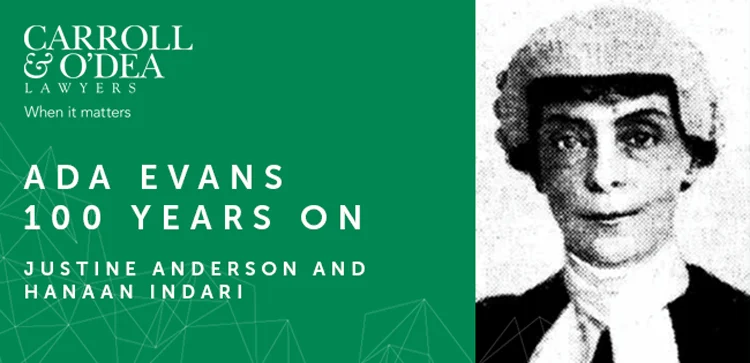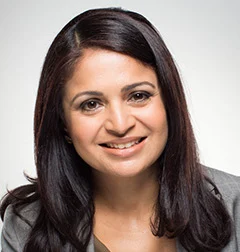
Ada Evans – 100 years on
Published on May 12, 2021 by Hanaan Indari
12 May 2021 marks 100 years since Ada Evans, female legal pioneer, was admitted to the NSW Bar after a near 20 year battle to be admitted into practice. Associate and Vice President of the Women Lawyers Association of NSW, Justine Anderson, takes a look at Ada Evans’ remarkable career and the key role she played forging a path for women in the law as the first woman to complete a law degree in Australia.
Who is Ada Evans?
Ada Evans was born in Wanstead, England in 1872. She was the youngest daughter of architect Henry Griffiths Evans & his wife Louisa Cansdell. [1] Her mother came from a family of lawyers.[2]
Her family relocated to Sydney, Australia in 1883 where she first attended Sydney Girls High School and then began her tertiary education at the University of Sydney, graduating with a Bachelor of Arts in 1895.[3]
In 1899, Ada’s mother, Louisa, encouraged her to enroll again to the University of Sydney, but this time in the Sydney Law School. Ada was convinced there was a need for women trained in the law to counter the prejudices of an all male legal system.[4] By all accounts the Dean of Law at the time, Professor Pitt Cobbett would not have permitted a woman to enroll, fortuitously, he was overseas at the time Ada applied and Ada entered the law school unimpeded. Upon his return, he advised Ada that “that she did not have the physique for law and would find medicine more suitable“.[5] Such other wisdom was imparted upon her by Mr Jethro Brown “if you cannot reap all the reward of your toil, the greater glory may be yours of sowing that others may reap – the glory of the pioneer’.[6]
Ada Evans completed her studies at the University of Sydney Law School passing all her examinations in 1902. She was the first woman to complete a law degree in Australia.
Although Ada had graduated, the Supreme Court refused her application to be registered as a student-at-law on the ground there was no precedent; there was a line of judicial authority, testimony to the creative genius of the common law as administered by men, that women were not “persons” and could not avail themselves of rights or privileges not specifically conferred on women.[7]
Ada applied to the New South Wales Bar to practise as a barrister, but again her application was rejected on the basis of her sex; she also applied to the English Bar but was similarly prevented from admission.[8]
On 18 September 1905, Ada Evans wrote a letter to then Attorney General Wade referred to an application she made before graduating in law for permission to take the examinations required for admission as a Conveyancer, she was refused.
Ada wrote numerous letters to successive governments requesting that the law be altered, however, she observed no change in New South Wales, despite bills being passed in other jurisdictions allowing for women to practise law.
Such was the gravity of what Ada was attempting to achieve that as a consequence of letter she had written dated 28 July 1917, Evans stated that she had been informed by the Court it would be necessary to change the law before a woman could be admitted. According to legal historian Joan O’Brien, she found reports that in 1915, a transcript of deputation of the Chief Justice, Sir Frederick Darley having placed the matter of Ada’s entrance into the legal profession, before the full bench of Judges and of their having decided it was a matter for Parliament.[9]
On 21 December 1918, the Women’s Legal Status Act 1918 (NSW) became law; permitting some women to become qualified barristers and solicitors and practise in the courts.[10] This was one of the most significant pieces of legislation affecting the NSW legal profession in the 20th century – it also gave women the right to be elected to the Legislative assembly.[11]
Ada Evans campaigned from 1902 to 1918.
In May 1919, Ada registered as a student-at-law in May 1919. After serving her two year term as a student-at-law and on 12 May 1921, Ada Evans was the first woman barrister in New South Wales.[12] After a struggle of sixteen years, and the persistence of a dedicated group of feminists committed to social reform, a woman was finally admitted to the Bar in New South Wales.[13]
Although Ada was offered briefs as a barrister immediately, she declined to practise citing her family commitments and the passage of time since her graduation and saying that she didn’t want “women’s standing in the profession to be undermined by a show of incompetence“.[14]
Why is Ada Evans important?
Ada’s political campaign culminated in the enactment of the Women’s Legal Status Act 1918 (NSW) which enabled her to become enrolled as a student-at-law and, in 1921, to be admitted to the bar.[15]
The legislation paved the way for women to enter the legal profession; that is not to say it made it an easy path to follow; many of our founding female practitioners were prejudiced against on the basis of sex. Some dissuaded from even practising law. They often could not obtain entry into firms to undergo articles and certainly found it difficult to seek out masters, or they could not find floors that would allow them to rent chambers or tutors that would mentor them. Most of the founding woman that entered the profession had male family members already in the law and so they leant on their connections to find a place in the law.
Lest to say there was a strong bond between women in the legal profession which has continued to today.
Who came after Ada Evans?
In 1905, Ms Flos Greig become the first Australian woman to enter the legal profession when she was admitted as a barrister in Victoria.[16] Ms Flos Greig became the first Australian woman to practise a barrister in Australia.
Ms Sibyl Morrison became the first woman to practise at the New South Wales Bar – she was admitted on 2 June 1924.[17]
In 1924, Ms Marie Byles became New South Wales’ first female solicitor when she graduated from the University of Sydney Law School.[18] Byles was admitted into the Supreme Court of NSW on 4 June 2024; it was such a newsworthy event a notice was published in the Sydney Morning Herald titled “First Lady Solicitor”.[19] The NSW Law Almanac of 1925 also chronicled this event in their publication.[20] In 1921, upon her graduation, she was awarded a prize in International Law for Women candidates bequeathed by feminist Rose Scott.[21] It wasn’t all easy sailing for Marie, after she was admitted she attempted to practise as a solicitor she was told she could be nothing more than a secretary; disgruntled with this reality & the effort she had exuded in obtaining her degree she found it difficult to obtain employment. The Dean of Law at Sydney University Sir John Peden persuaded Henry Davis & Co to give her an opportunity; the firm asked Byles to pay double the usual premium to her master solicitor during her training and the articles of her clerkship. In 1929 she established her own practice in Eastwood; Byles became the first female solicitor master – she opened the door for many women mastering for them after the war.[22]
In 1925, Ms Mary Kitson and Ms Dorothy Sommerville established the first legal partnership in Adelaide.[23]
Much later, in 1965, Roma Mitchell was appointed as the first female judge in Australia; she was appointed to the South Australian Supreme Court bench.
New South Wales’ first female Judge was Jane Mathews AO. The Honourable Jane Mathews AO was admitted to the bar in 1969, she became the first female crown prosecutor 8 years later, and in 1980 she was the first female judge appointed to the District Court of NSW. In 1987, she was the first female judge appointed to the Supreme Court of NSW before serving on the Federal Court of Australia and then as the president of the Australian Appeal Tribunal and deputy president of the Native Title Tribunal.[24]
The Honourable Mary Gaudron QC was the first female Solicitor-General appointed in 1981, she was the first female to take silk in 1981 and she was the first female to be appointed to the High Court in 1987.
Without Ada and her unwavering pursuit to obtain admission into the profession; the abovenamed women, and those unnamed, would not have been able to reach the intellectual heights they achieved and continue to achieve. The body of law would be far different in the absence of women in practise and so to Ada we, your fellow female practitioners, say thank you.
[1] Wikipedia, Ada Evans <https://en.wikipedia.org/wiki/Ada_Evans>.
[2] O’Brien, Joan, A History of Women in the Legal Profession in New South Wales (April 1986).
[3] Wikipedia, Ada Evans <https://en.wikipedia.org/wiki/Ada_Evans>.
[4] O’Brien, Joan, A History of Women in the Legal Profession in New South Wales (April 1986).
[5] Wikipedia, Ada Evans <https://en.wikipedia.org/wiki/Ada_Evans>.
[6] O’Brien, Joan, A History of Women in the Legal Profession in New South Wales (April 1986) 9
[7] Gaudron, Mary (13 June 2002). “Speech for Women Lawyers Association of New South Wales 50th Anniversary Gala Dinner”. Women Lawyers Association of New South Wales on 19 August 2006.
[8] Wikipedia, Ada Evans <https://en.wikipedia.org/wiki/Ada_Evans>.
[9] O’Brien, Joan, A History of Women in the Legal Profession in New South Wales (April 1986) 12.
[10] McLeod, Anne, The summit of her Ambition (Anne McLeod, 2016) 13.
[11] Ibid.
[12] Ibid.
[13] O’Brien, Joan, A History of Women in the Legal Profession in New South Wales (April 1986) 19.
[14] The Law Society of New South Wales, After Ada: a new precedent for women in law, 29 October 2002, 5.
[15] Justice Mary Gaudron, “Speech for Women Lawyers Association of New South Wales 50th Anniversary Gala Dinner”. (Speech, Women Lawyers Association of New South Wales, 13 June 2002).
[16] The Law Society of New South Wales, After Ada: a new precedent for women in law, 29 October 2002, 5.
[17] O’Brien, Joan, A History of Women in the Legal Profession in New South Wales (April 1986) 22.
[18] The Law Society of New South Wales, After Ada: a new precedent for women in law, 29 October 2002, 5.
[19] McLeod, Anne, The summit of her Ambition (Anne McLeod, 2016) 17.
[20] McLeod, Anne, The summit of her Ambition (Anne McLeod, 2016) 17.
[21] McLeod, Anne, The summit of her Ambition (Anne McLeod, 2016) 13.
[22] The first 100 years et al, Marie Byles, 2018 <https://first100years.com.au/marie-byles/>.
[23] The Law Society of New South Wales, After Ada: a new precedent for women in law, 29 October 2002, 7.
[24] Jerome Doraisamy, ‘Tribute flow for NSW’s First female judge’, Lawyers Weekly, (https://www.lawyersweekly.com.au/wig-chamber/26424-tributes-flow-for-nsw-s-first-female-judge, 3 September 2019).
